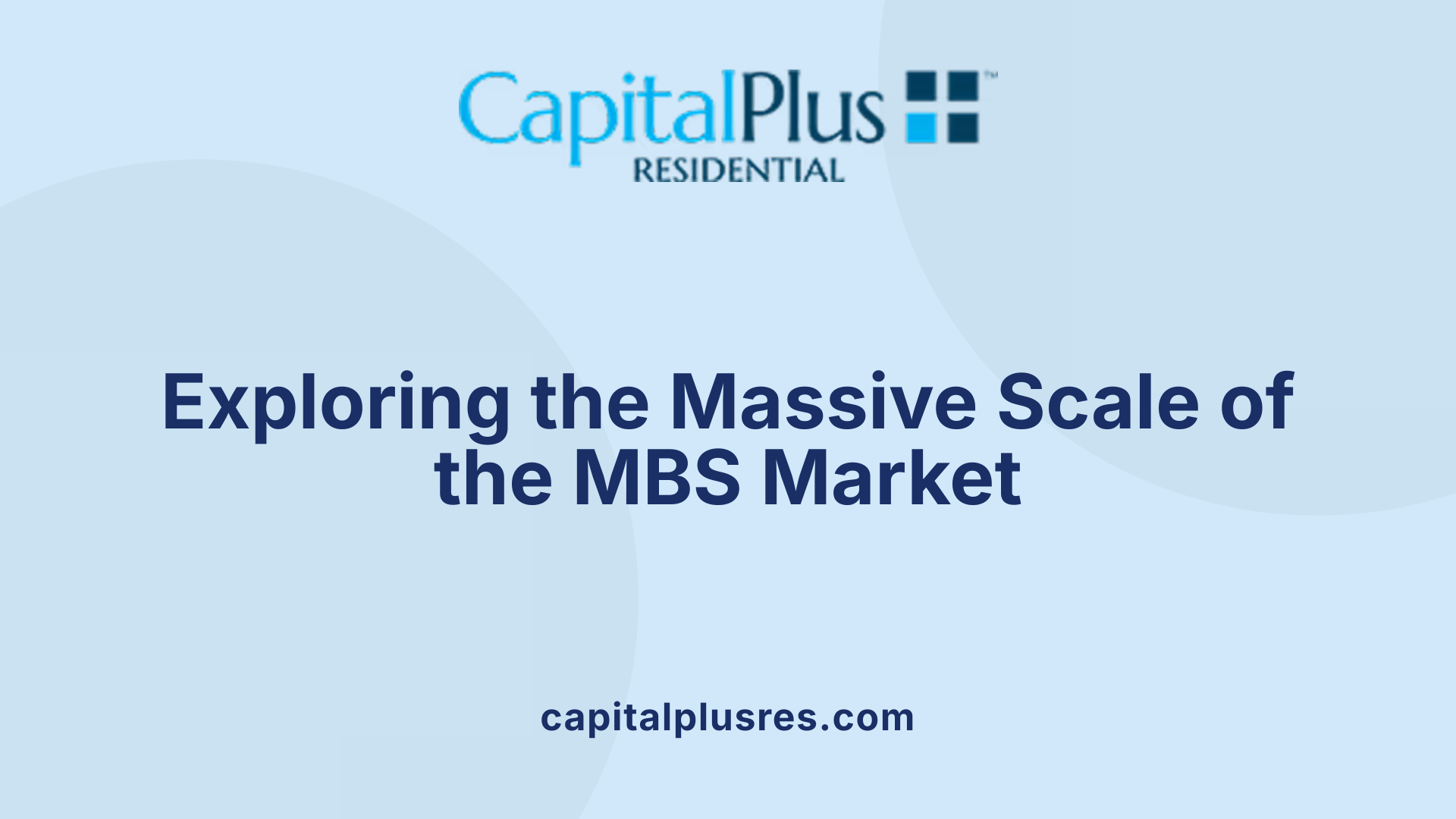Exploring the Backbone of Modern Residential Lending
Mortgage-backed securities (MBS) play a pivotal role in the residential lending market, connecting mortgage originators and investors through a sophisticated process that supports housing finance. This article unpacks the structure, functions, risks, and impact of MBS in today's economy, offering readers a comprehensive understanding of these vital financial instruments.
What Are Mortgage-Backed Securities?
Definition of MBS
Mortgage-backed securities (MBS) are investment products composed of pools of multiple residential mortgages. These loans are bundled together and then sold as securities to investors.
Basic Structure and Function
The creation of an MBS begins with mortgage lenders selling individual home loans to aggregators or government-sponsored enterprises (GSEs) like Fannie Mae, Freddie Mac, or Ginnie Mae. These entities pool the mortgages, securitize them by creating tradable securities, and issue these mortgage bonds to investors. The essential idea is to transform illiquid mortgage loans into liquid financial instruments.
Comparison with Bonds
Functionally, MBS behave much like bonds. Investors receive periodic payments that consist of both interest and principal from the underlying mortgage pool. Payments generally happen monthly, mirroring homeowners’ mortgage repayments. Unlike traditional bonds, however, MBS cash flows can be influenced by prepayment or default risks, which may adjust payment timings and amounts.
Source of Payments
The cash flow to MBS investors comes directly from the mortgage borrowers who make monthly payments on their home loans. These payments typically include both principal amortization and interest. The mortgage servicers handle payment collection and distribute these funds to MBS holders, providing investors with income streams derived from the underlying mortgage pool.
The Securitization Process: From Mortgage to Security

Loan Origination
Mortgage-backed securities (MBS) begin with the origination of individual mortgage loans. Banks, mortgage companies, and other lenders issue loans to homebuyers or property owners. These loans, secured by residential or commercial properties, set the foundation for the pool of debts to be packaged later.
Pooling of Mortgages
Once these individual mortgages are originated, they are gathered together into large pools. This pooling combines many separate loans, each with its own payment schedules and terms, into a single collective asset. Pooling increases diversification and helps stabilize the cash flows for investors.
Securitization Steps
The next step involves securitization, where these pooled mortgages are converted into securities that investors can buy. This process includes:
- Purchasing the mortgage loans from originators
- Combining these loans into mortgage pools
- Structuring them into securities that promise specific payment streams
Government-sponsored enterprises like Fannie Mae, Freddie Mac, and Ginnie Mae typically lead this process in the U.S., with Ginnie Mae securities fully backed by the U.S. government and others with implied guarantees.
Issuance and Servicing
After securitization, the MBS are issued to the market and sold to investors such as pension funds, insurance companies, and mutual funds. Mortgage servicers then take over, managing the collection of monthly mortgage payments from homeowners and distributing these payments—both principal and interest—to MBS investors. Effective servicing ensures investors receive timely payments and maintains the integrity of the cash flow in these securities.
This entire securitization process transforms individual mortgage loans into tradable securities, providing liquidity back to the mortgage market, enabling lenders to offer more home loans, and offering investors access to a diversified income-generating asset.
Types of Mortgage-Backed Securities and Their Structures
Pass-through securities explained
Pass-through securities are the most common type of mortgage-backed securities (MBS). In this structure, mortgage payments collected from homeowners—both principal and interest—are pooled together and passed directly to investors on a pro-rata basis. These monthly payments fluctuate based on actual mortgage repayments and prepayments, making cash flows somewhat variable. Principal amortization occurs over the life of the security, reflecting the underlying mortgages.
Collateralized Mortgage Obligations (CMOs)
CMOs are more complex MBS designed to address some of the unpredictability of pass-through securities. CMOs divide the pool of mortgage payments into different classes or "tranches," each with distinct maturity schedules and risk profiles. This allows certain tranches to have more predictable cash flows while others absorb variability.
Tranches and risk profiles
Tranches in CMOs are structured to meet different investor preferences. For example, priority tranches like Planned Amortization Classes (PACs) and Targeted Amortization Classes (TACs) receive steady payments and have reduced prepayment risk. Conversely, support tranches absorb payment fluctuations, bearing higher risk but potentially higher returns. This layered design helps investors tailor their risk exposure according to their needs.
Other variations of MBS
Beyond pass-throughs and CMOs, there are other forms like Real Estate Mortgage Investment Conduits (REMICs) and stripped mortgage-backed securities (SMBS). REMICs are legal entities that enable the distribution of income to multiple classes of investors, often used to create CMOs. Stripped MBS separate principal and interest payments into separate securities, allowing investors to target specific cash flow characteristics. Additionally, commercial MBS (CMBS) focus on commercial property mortgages and have their own structures and risk considerations.
These various MBS types provide investors with a spectrum of options, balancing risk, return, and cash flow predictability while supporting liquidity in the mortgage market.
The Role of Government-Sponsored Enterprises in MBS

What roles do Fannie Mae, Freddie Mac, and Ginnie Mae play in the MBS market?
Fannie Mae, Freddie Mac, and Ginnie Mae are the primary government-sponsored enterprises (GSEs) involved in issuing and guaranteeing most mortgage-backed securities (MBS) in the United States. They serve as aggregators, purchasing mortgage loans from lenders to pool and securitize them into tradable MBS. This process increases liquidity in the housing finance market by enabling lenders to issue more mortgages.
Ginnie Mae: Stands out by providing a full U.S. government guarantee on MBS issued against pools of federally insured or guaranteed loans, such as FHA and VA loans. This backing ensures timely payment of principal and interest to investors.
Fannie Mae and Freddie Mac: These entities issue agency MBS backed by their own guarantees, with implicit support from the federal government, as they have authority to borrow from the U.S. Treasury. Their securities are highly rated and considered lower risk compared to non-agency MBS.
How does government backing and guarantees impact MBS?
Government backing provides confidence to investors, reducing credit risk and supporting market stability. Ginnie Mae’s full faith and credit guarantee makes its securities effectively risk-free in terms of default. Fannie Mae and Freddie Mac’s implied guarantees, while not explicit, also provide substantial credit assurance, contributing to their high credit ratings and direct acceptance as core bond holdings in portfolios.
What are the distinctions between agency and non-agency MBS?
Agency MBS: These are issued or guaranteed by GSEs like Fannie Mae, Freddie Mac, or Ginnie Mae. They carry lower credit risk due to government involvement and dominate the market, with over three-fifths of U.S. mortgages securitized as agency MBS.
Non-agency MBS: Issued by private institutions such as banks and homebuilders, these securities lack government guarantees and therefore carry higher credit risk. They often include subprime or jumbo loans and have more complex risk profiles.
The agency MBS market exceeds $11 trillion in outstanding securities, reflecting its substantial role in mortgage financing, while non-agency MBS contribute to more diverse but riskier investment options.
Market Size and Significance of Mortgage-Backed Securities

How large is the US mortgage-backed securities market?
The mortgage-backed securities (MBS) market in the United States is immense, with outstanding securities exceeding $11 trillion as of recent counts and surpassing $12 trillion around 2021. This vast market underscores the critical role MBS play in the overall financial system and housing economy.
What is the average daily trading volume of MBS?
MBS enjoy substantial liquidity, reflected by an average daily trading volume approaching $300 billion. This high level of trading activity facilitates market efficiency and allows investors to buy and sell these securities relatively easily.
What portion of the mortgage market is represented by MBS?
Nearly three-fifths, or about 60%, of US mortgages are packaged into mortgage-backed securities. This significant share demonstrates how deeply integrated MBS are within the broader mortgage lending landscape.
How do mortgage-backed securities impact liquidity and mortgage lending?
Mortgage-backed securities enable lenders to sell their originated loans into the secondary market, freeing up capital to issue new mortgages. This process increases liquidity within the mortgage market, promoting more lending. Consequently, by influencing demand for mortgage loans, MBS can indirectly affect mortgage interest rates, often lowering them to improve homeownership affordability.
The scale and liquidity of the MBS market not only fuel mortgage lending but also contribute to the overall stability and efficiency of the housing sector and financial markets.
How MBS Affect Mortgage Rates and Housing Affordability
How Do Supply and Demand Dynamics of MBS Impact Mortgage Rates?
Mortgage-backed securities (MBS) significantly influence mortgage rates through basic supply and demand mechanics. When investors demand more MBS, prices for these securities rise. This increase in MBS prices lowers their yields, which in turn reduces mortgage interest rates, making borrowing cheaper for homebuyers.
How Does Investor Demand Affect Mortgage Rates?
Investor demand for MBS comes from a broad range of entities including pension funds, insurance companies, and governments. Strong demand means more capital flows into mortgage markets, allowing lenders to refinance or extend more mortgages at lower rates. Conversely, when demand weakens, mortgage rates tend to rise as MBS prices fall.
What Role Does the Federal Reserve Play in MBS Markets?
The Federal Reserve actively buys and holds large quantities of agency MBS to support the housing market. By purchasing these securities, the Fed raises their prices and thereby pushes down mortgage interest rates. This intervention encourages affordability by making home loans less expensive.
How Do MBS Prices Influence Mortgage Rate Fluctuations?
Changes in MBS prices have an inverse relationship to mortgage interest rates. If MBS prices drop due to lower investor interest or rising interest rates, mortgage rates increase. This dynamic directly impacts housing affordability by either encouraging or dampening demand for homes.
In summary, MBS markets and mortgage rates are closely connected through investor behavior, government intervention, and market pricing, ultimately influencing the cost of homeownership.
Investment Features and Yield Potential of MBS

Periodic income streams
Mortgage-backed securities (MBS) provide investors with periodic income streams similar to those of traditional bonds. These payments typically come monthly and consist of both interest and principal repayments derived from the underlying pool of mortgage loans. This steady cash flow makes MBS attractive to investors seeking regular income.
Yield Compared to Treasury Bonds
One compelling feature of MBS is their yield advantage over comparable U.S. Treasury securities. As of 2025, the average yield on the Bloomberg US MBS Index stands around 5.2%, which exceeds the yield on the 10-year Treasury note. This yield spread reflects the slightly higher risk and complexity involved in MBS versus government bonds, offering investors an enhanced return potential.
Bloomberg US MBS Index Yields
The Bloomberg US MBS Index is a widely accepted benchmark representing the performance and yield of agency mortgage-backed securities. Its yield offers a useful gauge of the income potential in this market segment. The income generated by securities in this index is derived from mortgage payments pooled from thousands of individual borrowers, which typically ensures a diversified stream of cash flows.
Portfolio Diversification Benefits
In addition to attractive yields, MBS contribute to portfolio diversification. Their performance is influenced by unique factors such as mortgage prepayment rates and interest rate changes, which differ from traditional equities or government bonds. Including MBS in a diversified investment portfolio can reduce overall volatility and enhance return stability, benefiting investors seeking balance in their fixed-income holdings.
Risks Inherent to Mortgage-Backed Securities
What is Prepayment Risk?
Prepayment risk is the possibility that homeowners will refinance or pay off their mortgages earlier than expected, usually when interest rates fall. This early repayment means investors receive principal back sooner, reducing the expected income stream and forcing them to reinvest at lower interest rates. Since MBS payments originate from mortgage payments, this risk significantly impacts the timing and amount of payments to investors.
What is Extension Risk?
Extension risk is the opposite of prepayment risk. It occurs when interest rates rise, causing homeowners to delay refinancing or early repayment. As a result, the average life of the mortgage-backed security lengthens, locking investors into lower yields for longer than anticipated. This risk can reduce the expected returns and makes cash flows more uncertain.
How Does Interest Rate Risk Affect MBS?
Mortgage-backed securities are sensitive to interest rate changes. Generally, MBS prices move inversely to interest rates; as rates go up, MBS prices fall, and vice versa. However, because of prepayment and extension risks, movements in rates can unpredictably affect cash flows. For instance, falling rates accelerate prepayments, shortening the investment horizon, while rising rates can extend it.
What Are Credit and Liquidity Risks?
Agency MBS issued by entities like Fannie Mae, Freddie Mac, and Ginnie Mae are considered to have high credit quality due to government backing, minimizing credit risk. However, non-agency or private-label MBS have greater credit risk, as they are not government guaranteed. Liquidity risk varies; some MBS trade actively and are liquid, whereas complex structures like collateralized mortgage obligations (CMOs) can be less liquid and more challenging to sell quickly without impacting price.
Understanding these risks is crucial for investors considering mortgage-backed securities, as they directly influence the investment’s performance and the predictability of cash flows.
Prepayment and Extension Risks Explained
How Homeowners' Refinancing Impacts MBS
Mortgage-backed securities (MBS) are directly affected by homeowners refinancing their mortgages. When interest rates drop, many homeowners choose to refinance, paying off their existing loans early. This prepayment shortens the expected life of the mortgages in the MBS pool.
Effect on Investors' Cash Flows
For investors, prepayments mean receiving their principal back sooner than anticipated. While this increases cash flow in the short term, it can be a disadvantage because investors must reinvest these repayments, often at lower prevailing interest rates. This scenario impacts the yield and overall return of MBS investments.
Opposite Dynamics of Extension Risk
Extension risk occurs when interest rates rise, and homeowners are less inclined to refinance or prepay. As a result, MBS investors face an extended duration of the security, which can lead to prolonged exposure to lower interest returns than newly available rates. This extension can reduce the expected yield and affect portfolio strategies.
PSA Prepayment Speed Models
To manage the uncertainty from prepayment and extension risks, investors use models like the PSA (Prepayment Speed Assumption) model. PSA models estimate the rate at which mortgages will be prepaid and help predict the average life and cash flow of MBS, allowing investors to better assess risk and expected returns.
Credit Quality and Ratings of Agency MBS
What are the credit ratings of agency MBS?
Agency mortgage-backed securities (MBS) issued by entities like Fannie Mae and Freddie Mac typically hold very high credit ratings, often rated as 'AAA' by major credit rating agencies. This reflects their strong creditworthiness and low risk profile, largely due to the quality of the underlying mortgage pools and the backing provided by the agencies.
How do agency MBS compare with non-agency MBS?
Compared to non-agency MBS, which are issued by private institutions and lack government affiliation, agency MBS are considered lower risk and more stable investments. Non-agency MBS carry greater credit risk as they do not have the same government sponsorship and often include subprime or riskier loans. Consequently, non-agency securities generally have lower credit ratings and higher yields to compensate for increased risk.
What is the difference between government guarantees and implied backing?
Ginnie Mae MBS come with an explicit full faith and credit guarantee from the U.S. government, ensuring timely payment of principal and interest to investors. On the other hand, Fannie Mae and Freddie Mac MBS have implied government backing—while not directly guaranteed by the government, these government-sponsored enterprises (GSEs) have the authority to borrow from the U.S. Treasury, which effectively supports their securities’ credit quality.
What characteristics make agency MBS high credit quality?
Agency MBS generally benefit from several factors that contribute to their high creditworthiness: stringent underwriting standards for mortgage originations, diversified loan pools, and active oversight by government agencies. Additionally, the securitization process includes servicing and management that help maintain payment flows. These features reduce credit risk, and the securities often carry low risk-based capital requirements for banks, making them attractive core assets in investment portfolios.
The 2007–2008 Financial Crisis Impact on Mortgage-Backed Securities
Role of Subprime MBS
Mortgage-backed securities (MBS) backed by subprime mortgages were central to the 2007–2008 financial crisis. These subprime MBS consisted of pools of loans to borrowers with weaker credit profiles, leading to a higher likelihood of default. When a rising number of homeowners defaulted or prepaid their loans unexpectedly, the value and cash flow of these securities plummeted, triggering widespread financial instability.
High-Risk Tranche Exposure
Many subprime MBS were structured into tranches with varying risk levels, including high-risk tranches that absorbed initial losses. These complex structures masked the true credit risk, leading investors to underestimate their exposure. The layered nature of tranches amplified losses during the crisis as defaults spread throughout the underlying mortgage pools.
Market Collapse and Government Intervention
The collapse of the subprime MBS market caused a significant loss of confidence among investors, severely restricting liquidity in the wider credit markets. This in turn led to the failure or distress of financial institutions heavily invested in these securities. Government intervention became necessary to stabilize the market, including actions such as bailouts, securitization reforms, and stricter regulatory oversight of MBS issuance.
Lessons Learned and Changes Since Crisis
Since the crisis, substantial regulatory reforms and improvements in transparency have been implemented. Agencies now require enhanced disclosures and stress testing of MBS products, while the creation of uniform mortgage-backed securities (UMBS) has increased market liquidity. Investor awareness of prepayment, extension, and credit risks has also improved, promoting more prudent investment and lending practices.
The financial crisis highlighted the risks inherent in certain MBS structures and stressed the importance of rigorous risk management and government oversight to sustain the health of the mortgage-backed securities market.
Mortgage Servicers and Their Influence on MBS Cash Flows
Servicing role and responsibilities
Mortgage servicers play a vital role in the lifecycle of mortgage-backed securities (MBS). They manage the day-to-day administration of the underlying mortgage loans, which includes collecting monthly payments from borrowers, handling escrow accounts, and addressing delinquencies or defaults. This operational duty ensures that mortgage payments are accurately tracked and maintained, directly affecting the cash flow characteristics of MBS.
Impact on monthly payment collection
Servicers collect monthly principal and interest payments from homeowners. The efficiency and reliability of this collection process are critical as they directly translate into the payments that MBS investors receive. Timely collection helps maintain steady cash flows, while any delays or mismanagement can create uncertainties or interruptions in payment streams.
Distribution to investors
After collecting payments, mortgage servicers are responsible for distributing the funds to investors who hold MBS. This includes the allocation of both interest and principal amounts. Servicers also manage reinvestment or the passing of prepayments, which can be irregular due to refinancing or early loan payoff by homeowners. The accuracy and timeliness of these distributions impact investor satisfaction and MBS market confidence.
Effect on MBS valuation
The quality of mortgage servicing can influence the valuation of MBS. Well-managed servicing leads to more predictable cash flows and reduces risks associated with delayed or lost payments. Conversely, poor servicing can heighten perceived risk, potentially lowering market prices or increasing yields demanded by investors. Additionally, servicer performance affects the modeling of prepayment risk and extension risk, which are critical factors in assessing MBS price and yield.
| Servicing Function | Description | Importance for MBS Investors |
|---|---|---|
| Payment Collection | Gathering monthly mortgage payments from borrowers | Ensures cash flow reliability and minimizes payment delays |
| Cash Flow Distribution | Allocating collected funds to MBS investors | Maintains investor confidence and timely returns |
| Delinquency Management | Handling late payments and defaults | Affects overall payment stability and risk assessment |
| Prepayment Processing | Managing early mortgage repayments | Influences prepayment risk and expected MBS duration |
Mortgage servicers are thus central to the operation and valuation of mortgage-backed securities, acting as the critical link between mortgage borrowers and MBS investors.
The Differentiation between Pass-Through Securities and CMOs
Cash flow distribution differences
Pass-through securities and collateralized mortgage obligations (CMOs) distribute cash flows to investors in fundamentally different ways. Pass-through securities pool mortgage payments and pass them directly to investors on a pro-rata basis. This means that each investor receives a fraction of the monthly principal and interest payments from the entire mortgage pool, including any prepayments made by homeowners.
In contrast, CMOs repackage pass-through securities into multiple classes or 'tranches'. These tranches receive principal and interest payments in a sequential or prioritized order, allowing for more tailored cash flow schedules. This structure provides investors with varying levels of predictability and risk, depending on the tranche they invest in.
Principal and interest payments
In pass-through securities, principal and interest payments are combined and paid monthly to investors proportionally. The amortization of principal occurs gradually over the life of the mortgage loan.
CMOs split these payments among tranches, which can have different maturities and payment priorities. Some tranches, such as Planned Amortization Classes (PACs), provide more predictable principal payments, while support tranches absorb variability and prepayment risk. This differentiation allows CMOs to manage unexpected changes in mortgage prepayment behavior more effectively.
Tranche structuring benefits
The tranche structure of CMOs offers significant benefits by reallocating risks associated with mortgage-backed securities. Investors seeking greater stability can choose tranches designed to reduce prepayment risk, while more risk-tolerant investors may opt for higher-yielding, more volatile support tranches.
This segmentation caters to a broader array of investment strategies, making CMOs versatile instruments within the MBS market compared to the simpler pass-through securities.
Investor choice based on risk tolerance
Investors select between pass-through securities and CMOs based on their appetite for risk and desired cash flow patterns. Pass-through securities are often favored for their simplicity and straightforward monthly payments, making them suitable for conservative investors.
CMOs appeal to those who prefer more control over risk exposure and cash flow timing, provided through the tranche system. The added complexity and potential for differing yields align with investors comfortable managing prepayment and extension risks inherent in mortgage-backed securities.
| Feature | Pass-Through Securities | Collateralized Mortgage Obligations (CMOs) |
|---|---|---|
| Cash Flow Distribution | Pro-rata monthly payments | Tranche-based, prioritized payments |
| Principal Payment Structure | Amortized evenly over time | Variable by tranche, some with prepayment protection |
| Risk Profile | Uniform risk exposure | Differentiated risk by tranche |
| Investor Suitability | Conservative, preferring simplicity | Varied, depending on tranche risk tolerance |
Investor Access to Mortgage-Backed Securities

Direct Purchase vs Mutual Funds and ETFs
Investors can access mortgage-backed securities (MBS) either by purchasing individual securities directly or through investment vehicles such as mutual funds and exchange-traded funds (ETFs). Buying MBS individually allows for greater control over the specific securities owned, but requires more expertise and typically involves larger minimum investments. In contrast, mutual funds and ETFs provide diversification and professional management, making MBS accessible to a broader range of investors with smaller capital.
Reinvestment of Principal Payments
One important consideration for MBS investors is the reinvestment of principal payments. Because MBS pay monthly principal and interest, investors who buy these securities must plan for the gradual return of principal over time. This distinguishes MBS from traditional bonds that return principal at maturity. Proper reinvestment strategies are necessary to maintain portfolio yield and manage cash flow variability caused by prepayments.
Liquidity Considerations
Liquidity varies based on the type of MBS and the market environment. Agency MBS, which are backed by entities such as Fannie Mae, Freddie Mac, and Ginnie Mae, generally enjoy high liquidity due to strong demand and government backing. However, more complex structures like collateralized mortgage obligations (CMOs) may experience lower liquidity and require more active management. Mutual funds and ETFs can mitigate some liquidity concerns by offering daily trading opportunities.
Suitability for Investor Portfolios
Agency MBS are recommended as part of core bond holdings within diversified portfolios because of their relatively high credit quality and attractive yields compared to U.S. Treasury securities. They provide investors with monthly income and diversification benefits, though the risks of prepayment, extension, and interest rate fluctuations mean they require careful consideration relative to investment goals and risk tolerance.
Tax Considerations for MBS Investors
How is interest income from MBS taxed?
Interest income from mortgage-backed securities (MBS) is fully taxable as ordinary income in the year it is received. Investors receive monthly payments that include both principal and interest, but only the interest portion is subject to regular income tax. This taxation can affect the after-tax yield for investors depending on their tax bracket.
What are the tax implications of buying MBS at discounts or premiums?
MBS investors may purchase securities at a discount or premium relative to their face value. These price deviations affect tax treatment: discounts may generate taxable income when the security is redeemed or amortized over time, while premiums may be amortized to reduce taxable income annually. These tax effects can be complex and may influence an investor's decision to hold or trade an MBS.
Why should investors seek tax advice for complex MBS scenarios?
Due to the complexities surrounding the taxation of MBS—such as discount or premium amortization, and potential tax consequences from prepayments or early redemptions—investors are advised to consult tax professionals. Expert guidance ensures compliance with tax laws and optimizes after-tax returns.
How do tax factors influence the attractiveness of MBS?
Although MBS often offer higher yields than comparable government bonds, their full taxation on interest income, paired with the complexities of discounts and premiums, can affect their net attractiveness. Investors must weigh these tax considerations when evaluating MBS as part of their overall portfolio, especially compared to tax-advantaged alternatives.
| Tax Aspect | Description | Investor Impact |
|---|---|---|
| Interest Income Taxation | Interest portion is fully taxable as ordinary income | Reduces after-tax yield |
| Discount and Premium Effects | Gains from discounts or amortization of premiums affect taxable income | Adds complexity; impacts timing of tax liabilities |
| Complexity and Advice | Complex tax rules require professional advice for proper handling | Ensures compliance and tax efficiency |
| Yield Versus Taxation | Higher gross yields can be offset by full taxation, affecting net returns | Influences investment decisions |
Innovations and Tools Supporting MBS Market Transparency
What are Uniform Mortgage-Backed Securities (UMBS)?
Uniform Mortgage-Backed Securities (UMBS) were introduced by the Federal Housing Finance Agency (FHFA) in 2019 to unify the offerings of Fannie Mae and Freddie Mac. These securities enhance liquidity by creating a single, standardized MBS that investors across the country can trade seamlessly. UMBS simplifies the market structure, improves pricing efficiency, and reduces fragmentation between issuers.
What disclosure tools are available for investors?
Fannie Mae provides advanced disclosure platforms such as DUS Disclose and PoolTalk. These tools give investors secure access to detailed loan-level data and legal documents for mortgage pools. DUS Disclose facilitates transparency for multifamily loans, while PoolTalk offers extensive analytics and updates for single-family mortgage pools. Together, they improve investor understanding of underlying loans, payment performance, and risk factors.
How do structured securities like Supers, Megas, and REMICs function?
Structured MBS like Supers and Megas are large-scale pools of mortgage loans that provide deeper market liquidity by combining existing securities into single entities. Real Estate Mortgage Investment Conduits (REMICs) organize MBS into multiple classes or 'tranches' with varying maturities and risk levels. This structure allows investors to select securities tailored to their cash flow needs and risk appetite while helping to distribute prepayment and extension risks more efficiently.
How do these innovations enhance market liquidity and transparency?
By introducing uniform securities and providing comprehensive disclosure platforms, the MBS market has become more accessible and transparent for all participants. Standardization through UMBS reduces trading complexities, while disclosure tools offer critical insights that support better risk assessment. Structured securities expand investment options, catering to diverse investor preferences and improving secondary market activity. Collectively, these innovations strengthen investor confidence and foster a more resilient mortgage finance market.
The Enduring Importance of Mortgage-Backed Securities
Mortgage-backed securities remain foundational to the residential lending landscape, offering essential liquidity to the market and investment opportunities with unique benefits and risks. Understanding their structure, underlying risks, and market dynamics empowers investors and industry participants to navigate these complex instruments effectively. Despite past controversies, MBS continue to be vital in supporting homeownership and shaping the broader economy.
References
- Understanding Mortgage-Backed Securities: Types, Risks ...
- Understanding Mortgage-Backed Securities Investing
- What Are Mortgage-Backed Securities?
- Mortgage-Backed Securities and Collateralized ...
- Understanding mortgage-backed securities
- Mortgage Backed Securities | MBS | Fannie Mae
- What Are Mortgage-Backed Securities?
- Mortgage-backed security
- What Are Mortgage Backed Securities?
Latest Blog


Get Pre-Approved Today
Start your secure online application now so you can get pre-approved for a mortgage (and close on your dream home) quickly within 5 minutes.









